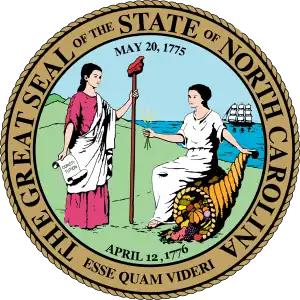| State Treasurer of North Carolina | |
|---|---|
 Seal of the North Carolina Department of the Treasury | |
| Member of | Council of State |
| Seat | Raleigh, North Carolina |
| Term length | Four years, no term limit |
| Inaugural holder | Memucan Hunt |
| Formation | 1715 Province of North Carolina January 1, 1784 State of North Carolina |
| Website | www |
The North Carolina State Treasurer is a statewide elected office in the U.S. state of North Carolina responsible for overseeing the financial operations of state government. The current state treasurer is Dale Folwell.
The office of state treasurer has existed since 1715 in the Province of North Carolina; at that time, the treasurer was appointed by the lower house of the legislature. In 1740, the treasurer's office was divided into two districts, and in 1779, into four. In 1784, the North Carolina General Assembly brought the treasurers under one single office, appointed jointly by both houses of the legislature.
Under the North Carolina Constitution of 1868, the treasurer became a position elected by popular vote, rather than appointed.
The North Carolina State Treasurer is an ex officio member of the North Carolina State Board of Education, the State Board of Community Colleges, the State Banking Commission, and the Council of State.
History of the office

The Fundamental Constitutions of Carolina, adopted in 1669, provided for a treasurer to handle "all matters that concern the public revenue and treasury" with the assistance of 6 undertreasurers and 12 auditors.[1] Despite this, early colonial governors of the Province of Carolina acted as their own treasurers due to minimal revenue. After the province incurred large debts during Cary's Rebellion and the Tuscarora War, the governor and his council appointed treasurers for each of the seven precincts of the province in 1711. In 1714 Governor Edward Hyde appointed Edward Moseley as treasurer of North Carolina and overseer of all precinct treasurers. He held the office until 1735, when he was made responsible for overseeing the "southern district" and William Downing was made responsible for the "northern district". The split system continued with different officeholders until 1776, when the North Carolina General Assembly required all treasurers to be appointed by themselves and barred them from holding other public offices.[1]
In 1779 and 1782, four and one additional treasury districts were respectively added, bring the total number to seven.[2] In 1784, the positions were folded into one office located in Hillsborough with a two-year term on a salary. Memucan Hunt was the first person to hold the new office. In 1795, the state treasury was relocated to Raleigh, the new capital of the state, and some of the treasurer's bookkeeping functions were given to the state comptroller. In 1868 North Carolina ratified a new constitution which stipulated that the office be filled by a popularly elected candidate with four-year terms.[1] From 1887 to 1899, the treasurer was responsible for oversight of the state banking industry.[3]
North Carolina received a triple A bond credit rating for the first time in the early 1960s—during the tenure of State Treasurer Edwin M. Gill—and maintained the rating throughout the rest of his time in office.[4] The Department of State Treasurer was created by the General Assembly in 1971.[5] John Haywood, who served for 40 years from 1787 until 1827, was the longest-tenured treasurer.[2] Janet Cowell, who assumed office in 2009, was the first woman to serve as state treasurer.[6] The incumbent, Dale Folwell, has served as treasurer since January 1, 2017.[7] He is the first Republican to hold the office since David A. Jenkins served during the Reconstruction era from 1868 to 1876.[8]
Powers, duties, and structure
The state treasurer is a constitutional officer.[9] Article III, Section 7, of the Constitution of North Carolina stipulates the popular election of the treasurer every four years.[10] The office holder is not subject to term limits.[11] In the event of a vacancy in the office, the Governor of North Carolina has the authority to appoint a successor until a candidate is elected at the next general election for members of the General Assembly.[10] They sit on the North Carolina Council of State[1] and are ex officio chairman of the State Banking Commission, member of the State Board of Education, and member of the State Board of Community Colleges.[9] They are sixth in line of succession to the governor.[12][13]
The treasurer leads the Department of State Treasurer,[9] which has six divisions: Retirement Systems Division, State Health Plan Division, Investment Management Division, State and Local Government Finance Division, Financial Operations Division, and Unclaimed Property Division.[14] The Local Government Commission is a subagency of the department[15][16] and the treasurer serves ex officio as chairman of the body.[17] The treasurer is the sole fiduciary of the governmental employee pension fund and manages the State Health Plan.[8] As with all Council of State officers, the treasurer's salary is fixed by the General Assembly and cannot be reduced during their term of office.[18] In 2022, the treasurer's annual salary was $146,421.[19]
List of State Treasurers

Colonial Treasurers
- Edward Moseley, 1715–1735[20]
Northern District
- William Downing, 1735–1739[21]
- William Smith, 1739–1740
- John Hodgson, 1740–1747[22]
- Thomas Barker, 1748–1752
- John Haywood, 1752–1754
- Thomas Barker, 1754–1764
- Joseph Montfort, 1764–1775
- Samuel Johnston, 1775
Southern District
- Edward Moseley, 1735–1749[20]
- Eleazer Allen, 1749–1750
- John Starkey, 1750–1765
- Samuel Swann, 1765–1766
- John Ashe, 1766–1773
- Richard Caswell, 1773–1775
State Treasurers
Districted
From 1777 to 1779, the State was divided into two districts, Northern and Southern, each with a treasurer. From 1779 to 1782, there were six districts, each with a treasurer, as follows: Edenton, Salisbury, Hillsboro, Halifax, New Bern, Wilmington. In 1782, a seventh district-Morgan-was created. In 1784, the district system was abandoned.[23][24][25]
- John Ashe, 1777–1781 (Southern District, later Wilmington District)
- William Skinner, 1777–1784 (Northern District, later Edenton district)
- Green Hill, 1779–1784 (Halifax District)
- Richard Cogdell, 1779–1784 (New Bern District)
- William Cathey, 1779–1781 (Salisbury District)
- Matthew Jones, 1779–1782 (Hillsboro District)
- Timothy Bloodworth, 1781–1784 (Wilmington District)
- Robert Lanier, 1782–1784 (Salisbury District)
- Memucan Hunt, 1782–1784 (Hillsboro District)
- John Brown, 1782–1784 (Morgan District)
- Benjamin Exum, 1782–1784 (New Bern District)
Whole state
| No. | State Treasurer | Term in office | Source | |
|---|---|---|---|---|
| 1 | Memucan Hunt | 1784 – 1787 | [2] | |
| 2 |  |
John Haywood | 1787 – 1827 | [2] |
| 3 | William S. Robards | 1827 – 1830 | [2] | |
| 4 | William S. Mhoon | 1831 – 1835 | [2] | |
| 5 | 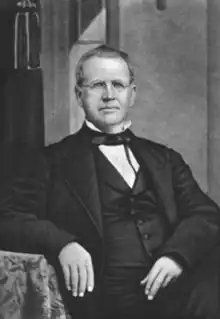 |
Samuel F. Patterson | 1835 – 1837 | [2] |
| 6 |  |
Daniel W. Courts | 1837 – 1839 | [2] |
| 7 | Charles L. Hinton | 1839 – 1843 | [2] | |
| 8 |  |
John H. Wheeler | 1843 – 1845 | [2] |
| 9 | Charles L. Hinton | 1845 – 1851 | [2] | |
| 10 |  |
Daniel W. Courts | 1851 – 1863 | [2] |
| 11 | .jpg.webp) |
Jonathan Worth | 1863 – 1865 | [2] |
| 12 | William Sloan | 1865 – 1866 | [2] | |
| 13 |  |
Kemp P. Battle | 1866 – 1868 | [2] |
| No. | State Treasurer | Term in office | Party | Source | |
|---|---|---|---|---|---|
| 14 | David A. Jenkins | 1868 – 1876 | Republican | [2] | |
| 15 | 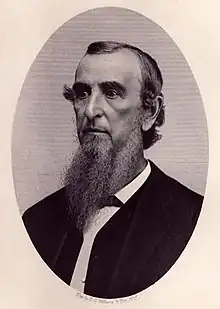 |
John M. Worth | 1876 – 1885 | Democratic | [2] |
| 16 |  |
Donald W. Bain | 1885 – 1892 | Democratic | [2] |
| 17 |  |
Samuel McDowell Tate | 1892 – 1895 | Democratic | [2] |
| 18 |  |
William H. Worth | 1895 – 1901 | Populist | [2] |
| 19 |  |
Benjamin R. Lacy | 1901 – 1929 | Democratic | [2] |
| 20 |  |
Nathan O'Berry | 1929 – 1932 | Democratic | [2] |
| 21 | John P. Stedman | 1932 | Democratic | [2] | |
| 22 |  |
Charles M. Johnson | 1933 – 1949 | Democratic | [2] |
| 23 |  |
Brandon P. Hodges | 1949 – 1953 | Democratic | [2] |
| 24 | 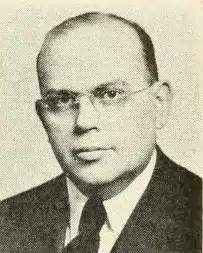 |
Edwin M. Gill | 1953 – 1977 | Democratic | [2] |
| 25 | Harlan E. Boyles | 1977 – 2001 | Democratic | [2] | |
| 26 | Richard H. Moore | 2001 – 2009 | Democratic | [2] | |
| 27 |  |
Janet Cowell | 2009 – 2017 | Democratic | [2] |
| 28 | 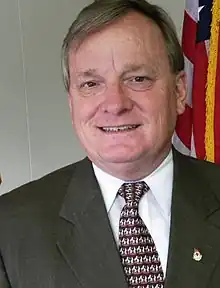 |
Dale Folwell | 2017 – present | Republican | [2] |
References
- 1 2 3 4 Towles, Louis P. (2006). "Treasurer". NCPedia. North Carolina Government & Heritage Library. Retrieved August 6, 2022.
- 1 2 3 4 5 6 7 8 9 10 11 12 13 14 15 16 17 18 19 20 21 22 23 24 25 26 27 28 29 30 "History of North Carolina Treasurers". North Carolina Department of State Treasurer. Retrieved October 13, 2022.
- ↑ "History". North Carolina Office of the Commissioner of Banks. Retrieved March 17, 2023.
- ↑ North Carolina Manual 2001, p. 224.
- ↑ North Carolina Manual 2011, p. 134.
- ↑ North Carolina Manual 2011, p. 182.
- ↑ Jimison, Jon (January 1, 2017). "Dale Folwell sworn in as NC's treasurer minutes into 2017". Winston-Salem Journal.
- 1 2 MacMillan, Mike (July 1, 2022). "State Treasurer Dale Folwell relishes the chance to stir it up". Business North Carolina. Retrieved February 5, 2023.
- 1 2 3 North Carolina Manual 2011, p. 175.
- 1 2 North Carolina Manual 2011, p. 138.
- ↑ "Terms of Office". North Carolina State Board of Elections. Retrieved August 6, 2022.
- ↑ "States' Lines of Succession of Gubernatorial Powers" (PDF). National Emergency Management Association. May 2011. Retrieved August 5, 2022.
- ↑ Orth & Newby 2013, p. 115.
- ↑ "Divisions". North Carolina Department of State Treasurer. Retrieved February 8, 2023.
- ↑ Parker 2013, pp. 694, 713.
- ↑ Vaillancourt, Cory (November 9, 2022). "NC's Local Government Commission returns to its roots in Western North Carolina". Smoky Mountain News. Retrieved June 22, 2023.
- ↑ Stick, David (2006). "Local Government Commission". NCPedia. North Carolina Government & Heritage Library. Retrieved August 6, 2022.
- ↑ Orth & Newby 2013, p. 125.
- ↑ "What raises are NC teachers, state employees getting in 2022". The News & Observer. July 20, 2022. Retrieved August 4, 2022.
- 1 2 Price, William S.; Dease, Jared (December 2022). "Moseley, Edward". NCPedia. North Carolina Government & Heritage Library. Retrieved June 24, 2023.
- ↑ Reidinger, Martin. "Downing, William". NCPedia. North Carolina Government & Heritage Library. Retrieved January 24, 2023.
- ↑ Stumpf, Vernon O. "Hodgson, John". NCPedia. North Carolina Government & Heritage Library. Retrieved June 25, 2023.
- ↑ Connor, R.D.D. (1913). "North Carolina Manual".
- ↑ Connor, R.D.D. (1913). A Manual of North Carolina (PDF). Raleigh: North Carolina Historical Commission. p. 441. Retrieved April 27, 2019.
- ↑ Wheeler, John H. (1874). "The Legislative Manual and Political Register of the State of North Carolina". p. 441. Retrieved April 9, 2019.
Works cited
- North Carolina Manual. Raleigh: North Carolina Secretary of State. 2001. OCLC 436873840.
- North Carolina Manual (PDF). Raleigh: North Carolina Department of the Secretary of State. 2011. OCLC 2623953.
- Orth, John V.; Newby, Paul M. (2013). The North Carolina State Constitution (second ed.). Oxford University Press. ISBN 9780199300655.
- Parker, Adam C. (January 2013). "Still as Moonlight: Why Tax Increment Financing Stalled in North Carolina". North Carolina Law Review. 91 (2): 661–719.
